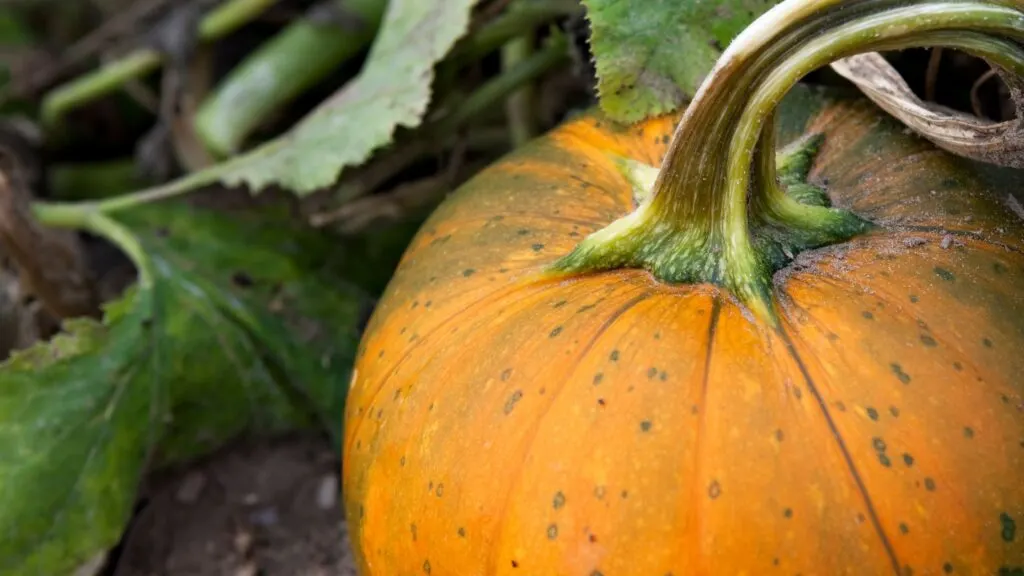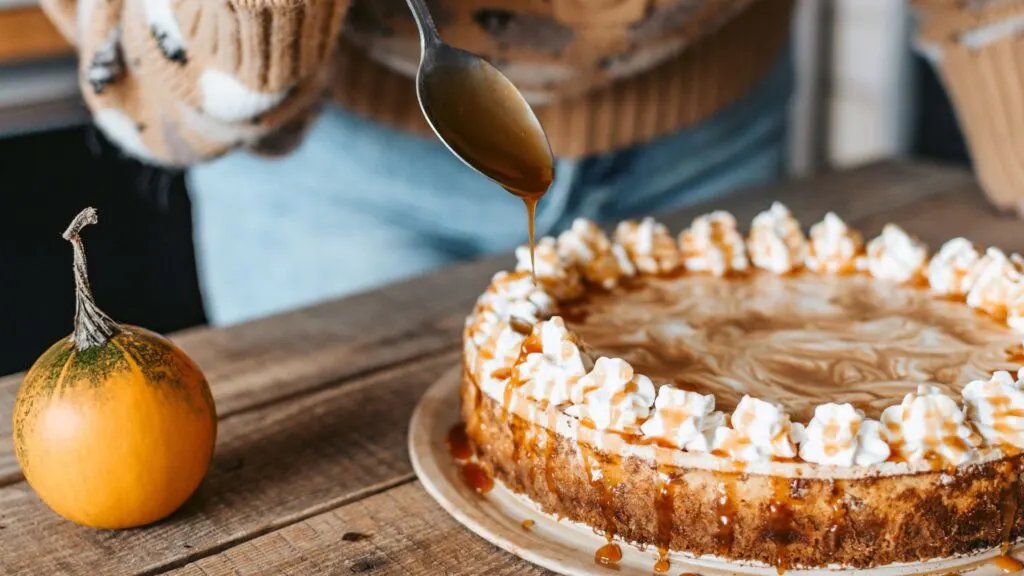That’s it, I told my husband, I’m not doing a garden this year.” You said that last year, He says. I know, but this year, I mean it.
Well, maybe I’ll do the easy stuff. He replies that he will be sticking to his pumpkins again because, you know what, they are the easiest things to grow around here. And he is right.
Growing pumpkins is worth trying this year if you have any livestock, chickens, or ducks on your homestead. You don’t have to have much space, but if you do, you can let the pumpkins grow wild. It’s one of the easiest and most rewarding plants to start growing.

Pumpkins are a beloved fall staple in many parts of the world. These large, round orange fruits are delicious and packed with nutrients. They have a rich history dating back thousands of years and are used for everything from carving spooky Halloween decorations to making tasty pies and soups.
This article will explore how to grow pumpkins in your yard, including everything from preparing the soil and selecting seeds to harvesting and storing your pumpkins.
Best Time to Plant Pumpkins
First, it’s important to understand the seasonality of pumpkins. Pumpkins are typically planted in late spring or early summer once the soil has warmed to at least 60 degrees Fahrenheit. They require plenty of sunlight and warm temperatures to thrive, so it’s best to plant them in a location that receives full sun for most of the day.

Is August too late to plant pumpkins?
It depends on the variety of pumpkin, the length of your growing season, and your local climate. For many pumpkin varieties, it could be too late to plant pumpkins in August if you have a relatively short growing season.
Most pumpkin varieties take around 90-120 days to mature, and you will want to factor in an additional few weeks for curing and storing after harvest.
However, some pumpkin varieties can mature more quickly, and you can get an early start by planting seeds indoors and transplanting seedlings when they are 2-3 weeks old.
If you have a long growing season and live in a warm climate, you can successfully plant pumpkins later in the summer. It’s always a good idea to check with your local cooperative extension office or a reputable gardening resource for advice specific to your region.
It’s also essential to choose a variety of well-suited pumpkins for your growing zone, as some varieties do better in certain regions than others.
Planting Pumpkin Seeds
Pumpkins require plenty of space to grow, so make sure to plant pumpkin seeds at least 6 feet apart. You can also train the vines to grow in a specific direction by gently guiding them with trellises or stakes. You can also use the cattle panels from Tractor supply.
Pick miniature pumpkins like Jack Be Little’s if you don’t have enough space to grow pumpkins.

Preparing the Soil
Preparing the soil is the first step in growing healthy pumpkins. Pumpkins require well-draining soil that is rich in nutrients. Begin by removing any rocks or debris from the planting area, and then loosen the soil to a depth of at least 12 inches. Add compost or well-rotted manure to the soil to improve its fertility and texture.
We started growing our pumpkins right over our compost area. We thought we would see how easily the pumpkins would sprout in the pig pen. If you have pigs, you will see all sorts of things starting to grow after you feed them, zucchini, pumpkins, tomatoes, and whatnot with the seeds.

The other benefit of pumpkin plants over our compost pile was hills. It wasn’t a straight, smooth area, and pumpkins love hills of dirt. This is better for the water to drain and the vines to grow.
So we tried planting pumpkin seeds around our compost pile, and they took off! We didn’t have to do any weeding or prepare the soil—lazy gardening at its finest.
Another benefit of our compost pile was the soil was fertilized. I’ve read how important it is to fertilize your pumpkins, and we never have in the last five years of growing them because we always do it right over and near the compost area.
If you don’t have a compost area, you can grab an all-purpose fertilizer for a vegetable garden.

Best Pumpkin Plants
When it comes to picking pumpkin seeds, there are many different varieties. Some popular options include Jack O’Lantern, Sugar Pie, and Cinderella pumpkins. Look for seeds labeled as disease-resistant and suited to your growing zone.
This is an enjoyable pack of pumpkin seeds from Amazon.
One of the benefits of growing pumpkins is that they can be cultivated organically without the use of harmful chemicals. You can control pests and diseases using natural remedies such as neem oil, diatomaceous earth, or insecticidal soap.
When To Water Pumpkin Plant
When watering your pumpkins, keeping the soil moist but not waterlogged is essential. Water deeply once a week or more often during periods of drought. Avoid getting water on the leaves or fruit, as this can increase the disease risk.
Infected Plants
Pumpkins, like any other plant, can have disease.
Powdery mildew, Downy mildew, Anthracnose, Bacterial wilt, and Vine borers are some of the more common ones, for tips on how to prevent these diseases, check out this post.

When To Harvest Pumpkins
Once your pumpkins are ripe, it’s important to harvest them at the right time. Look for signs that the stem has begun to dry out and turn brown and that the pumpkin’s skin is hard and cannot be easily punctured with a fingernail.
Use a sharp knife to cut the pumpkin from the vine, leaving a few inches of stem intact.
Saving Pumpkin Seeds for Planting.
The other thing I love about pumpkins is the seeds; it is so easy to save them for your harvest next year. This will save you money in the long run.
There are various frugal ways you can grow pumpkins in your backyard.
Here are a few frugal ways to grow pumpkins:
- Start with seeds: The least expensive way to plant pumpkins is to plant seeds directly in your backyard. You can either purchase seeds from a local hardware store or save your own seeds from a previous harvest.
- Compost: While you can purchase fertilizer or compost, these can be pricey. Instead, make your compost from kitchen scraps, grass clippings, and other yard waste. This can be a great way to give your pumpkins the nutrients they need to grow.
- DIY trellis: Instead of purchasing a trellis, make your own with materials available around your yard or home. You can use wooden stakes, bamboo poles, or even scrap metal or PVC pipes to create a trellis that will support your pumpkin vines as they grow.
- Save water: Pumpkins need a lot of water, but you don’t need to spend a lot on water bills. Water your plants in the early morning or evening to reduce evaporation, and consider using a rain barrel to collect water for your plants.
- Trade or share seeds: If you have gardening friends in your area, consider trading or sharing pumpkin seeds. This can be a great way to diversify your garden without spending extra money on seeds.

How to Store Pumpkins
Finally, storing your pumpkins properly can help them last for several months. Store them in a cool, dry place with good ventilation, such as a garage or shed. Avoid storing them near apples or other fruits that release ethylene gas, as this can cause the pumpkins to ripen too quickly and spoil.
In addition to being easy and inexpensive to grow, pumpkins offer a variety of health and economic benefits. They are packed with vitamins and minerals and can be used in various delicious recipes. Growing your pumpkins can also help reduce your carbon footprint and save money on store-bought produce.
In conclusion, growing pumpkins in your yard is a fun and rewarding experience with many benefits. You can easily cultivate healthy, organic pumpkins by following these tips and tricks. So why not try it and see what delicious pumpkin creations you can come up with?
Frequently Asked Questions About Pumpkins
How long does it take to grow a big pumpkin?
Depending on the variety of pumpkin you’re growing, it can take between 90 and 120 days for a full-size pumpkin to mature.
However, this process can take up to 180 days for giant pumpkins. It’s important to keep an eye on your pumpkins as they grow and notes their characteristic growth stages, which will help you determine when they are ripe and ready to harvest.
Do pumpkins need a lot of water?
Yes, pumpkins need quite a bit of water to grow properly. It’s recommended that you water your pumpkin plants deeply but gently. The amount of water can vary depending on the climate and soil type in your area, but generally, pumpkins should receive around one inch of water at a time. You will need to adjust the watering schedule based on the rain you are getting.
It’s essential to be careful not to overwater, as this can lead to disease and/or root rot. Pumpkins do not like soggy soil.
Do pumpkins come back every year?
Oh, pumpkins, they’re such independent spirits! They don’t want to be tied down like those perennials. Like a boss, these one-season wonders complete their growth cycle in a single growing season. But here’s a secret – they can be a real penny pincher’s dream come true!
They can even reseed themselves and pop back up next year without any effort on your part… if, and it’s a big if, they’ve gotten enough frost. But let’s be real here, getting a reasonable and consistent crop means planting new pumpkin seeds yearly.
Should I cut off dying pumpkin leaves?
Yes, it is recommended that you cut off dying pumpkin leaves to help your plant focus its energy on the healthier leaves and fruits. As long as most of the plant is still healthy and producing fruit, removing dying or diseased leaves can help your pumpkin plant stay healthy and productive.
How long can pumpkins be left on the vine?
Many pumpkin varieties will continue to grow and mature on the vine until the first frost. However, picking them before the first frost is essential, as this can damage the fruit and make them less suitable for eating.
Depending on the variety and growing conditions, you may be able to leave pumpkins on the vine for up to 100 days after they first appear.
Is early August too late to plant pumpkins? When is the best time to plant – early July?
Early August may be too late to plant pumpkins, as many varieties require 90-120 days to mature before the first frost. Planting in early July is a good time to plant, as pumpkins grow best in warm soil and require a long growing season.
Additionally, planting earlier in the season will give the pumpkins more time to ripen and mature before the arrival of cooler weather. It’s essential to consider your local growing conditions when deciding when to plant–different regions may have different optimal planting times, and environmental factors may impact your pumpkin’s growth and yield.

Here are some easy Pumpkin recipes to try:
Pumpkins are a versatile food that can be incorporated into various dishes.
Roasted Pumpkin Seeds: Rinse the pumpkin seeds, toss them with oil, salt, and any other desired seasoning, and bake at 300°F for 45 minutes or until golden brown, stirring occasionally. They make the perfect snack or topping for salads.
Pumpkin Soup: Cook onions and garlic, add cubed pumpkin, chicken broth, cream, and spices, and simmer until the pumpkin is tender. Then, blend it all until smooth for a delicious and comforting soup.
Pumpkin Smoothie: Blend canned pumpkin, banana, milk of choice, honey, and spices for a refreshing and nutritious drink.
Pumpkin Pancakes: Mix pumpkin puree, flour, eggs, sugar, milk, baking powder, and spices, and cook them on a griddle until golden brown. Serve with butter and syrup, and enjoy them for breakfast or brunch.
Roasted Pumpkin: Cut a small pumpkin into chunks and toss it with oil, salt, and any other desired seasonings. Roast them in the oven for 20-25 minutes until tender and lightly browned.
Pumpkin Cheesecake: Combine cream cheese, pumpkin puree, sugar, cinnamon, and other spices. Pour the mixture over a graham cracker crust and bake until set with a bit of jiggle still in the middle. Let it cool, then serve it topped with whipped cream. Recipe here.
In terms of recipes, pumpkins can be incorporated into various dishes, including pumpkin soup, pumpkin pie, and roasted pumpkin seeds. There are many options to choose from, and you can get creative with it.
Growing pumpkins in your yard is inexpensive and easy, requiring only a few preparations, the right care and attention, and the appropriate timing. By embracing pumpkin cultivation or gardening as a hobby, you can reap numerous benefits, such as better health, a beautiful garden, and substantial monetary savings.
